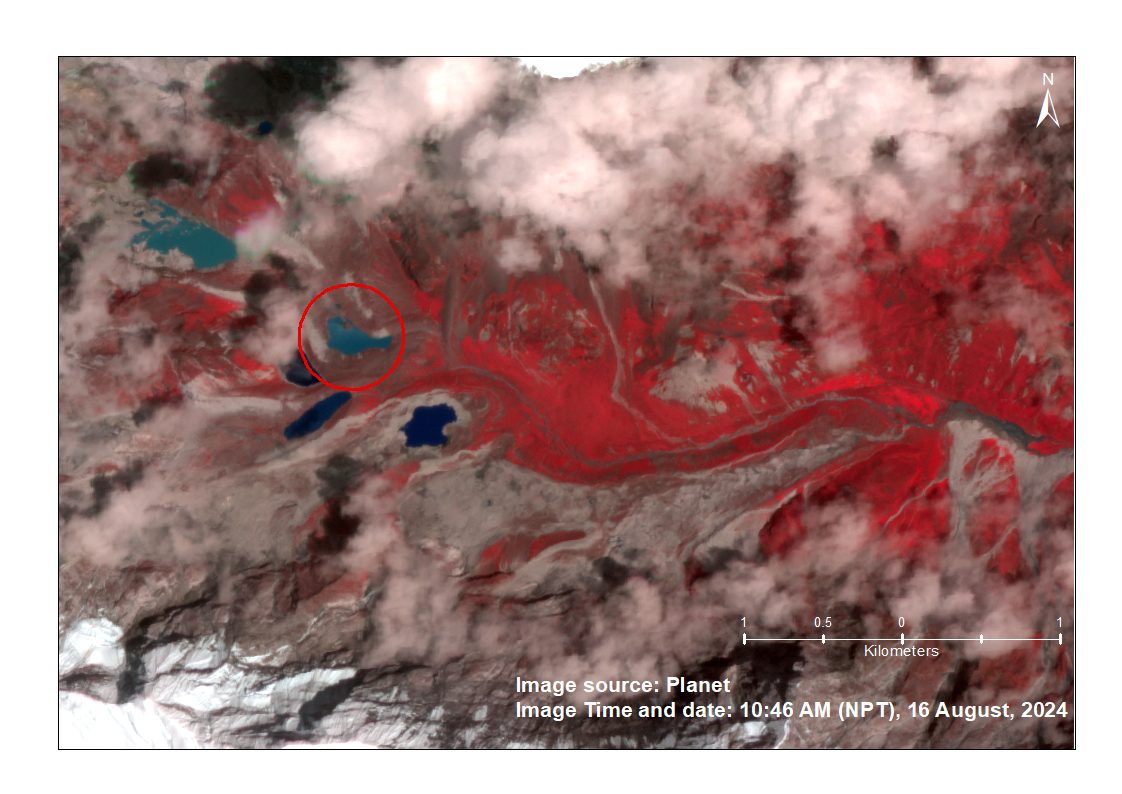This site uses cookies, as explained in our terms of use. If you consent, please close this message and continue to use this site.
The devastating flood which struck Thame, a village in the Khumbu region of Nepal, yesterday (16 August 2024) was due to an outburst flood from Thyanbo glacial lake.

Kathmandu, 17 August 2024
The devastating flood which struck Thame, a village in the Khumbu region of Nepal, yesterday (16 August 2024) was due to an outburst flood from Thyanbo glacial lake.
An initial assessment of damage by the local authorities shows 14 properties have been destroyed, including one school, one health post, five hotels and seven homes.
Thame is a prominent village in Namche region of Solukhumbu, home to renowned Everest mountaineers and current record holder Kami Rita Sherpa.
Several glacial lakes lie upstream of Thame. Satellite images of the area dating back to 2017 obtained by ICIMOD from the European Space Agency’s Copernicus earth observation programme show these lakes constantly changing in size. Researchers at ICIMOD confirm that some of them frequently expand and contract, making them susceptible to breaches.
Sentinel satellite imagery show the constant change in lake size located in upstream of Thame River. Animation prepared by Sudan Bikash Maharjan, Remote Sensing Analyst, ICIMOD.
These lakes lie near the popular trekking destination of Tashi Lapcha Pass. The neighbouring valley holds one of the region’s most potentially dangerous glacial lakes, Tsho Rolpa.
ICIMOD scientists are further investigating the causes of GLOF and its impact downstream, including seeking pre- and post-satellite images, in order to complement the efforts of national and local agencies, including Nepal’s Department of Hydrology and Meteorology.
ICIMOD’s 2023 assessment, Water, Ice, Society, and Ecosystems in the Hindu Kush Himalaya, stated that the glaciers, snow, and permafrost of the Hindu Kush Himalaya are “undergoing unprecedented and largely irreversible changes over human timescales, primarily driven by climate change” and “are some of the most vulnerable to these changes in the world.”
260 million people live in the mountains of the Hindu Kush Himalayas (HKH), and these mountain communities, the report continues, “are already living with the impacts of the accelerated melting of glaciers, changing snowfall patterns, growing variability in water availability, and increasing incidences of cryosphere-related hazards [posing] a direct impact on their lives and livelihoods.”
It warns floods and landslides are projected to increase, with climate the key driver in many of the water- and cryosphere-related disasters already recorded in recent years, through meltwater, larger and more potentially dangerous lakes, unstable slopes from thawing permafrost, and increasing sediment loads in rivers.
The retreat of mountain glaciers has increased the size and number of glacial lakes, and a three-fold increase in glacial lake outburst flood risk across the HKH is projected by the end of the twenty-first century, and it’s predicted we’ll reach ‘peak GLOF risk’ by 2050.
There are 25,000+ glacial lakes in the Hindu Kush Himalaya region, of which 47 potentially dangerous glacial lakes (PDGLs) lie within the Koshi, Gandaki, and Karnali river basins of Nepal, the Tibet Autonomous Region of China, and India. High Mountain Asia is a global hotspot for risk of GLOFs, with approximately one million people living within 10km of a glacial lake according to a new glacial lake inventory report. The growth in the number and size of glacial lakes is set to continue.

The lake’s size was approximately 0.05 km² on August 16, 2024, at 10:46 AM Nepal Standard Time, before it was breached. We estimate the breach occurred around 1:25 PM on the same day.
Tenzing Chogyal Sherpa, ICIMOD Cryosphere Analyst and founder of the #SaveOurSnow campaign, is from the Solukhumbu region where the floods hit. “This flood swept away parts of a village I know intimately well, where friends, neighbours and relatives live, with ancestral ties going back generations,” he said. “It is a painfully personal reminder of the devastating impacts of temperature rise on mountain communities. Millions of people in the mountains have contributed literally nothing to greenhouse gas emissions, but face the catastrophic impacts of these emissions with ever-increasing frequency and severity.
“The science is clear: G20 economies must cut their ties with fossil fuels, and accelerate the use of renewables, and to ensure adaptation and loss and damage funds reach those communities impacted. To mountain communities – raise your voice to call for this urgent action. As Thame shows, for many of us, continued inaction from world leaders poses an existential risk.”
Dr Nima Sherpa, a media and mountaineering outfitter from Khumbu, and supporter of #SaveOurSnow, said: “Thame was a beautiful village, home to many generations of Sherpa people and their family. [These homes] now [lie] buried under debris. It’s sad to see how the mountain communities are paying the price of the global climate crisis. Some complain about the recreational or cosmetic impacts of too much or too little snow; but these changes affect the lives of the people who live in the mountains so differently – impacting them directly and often catastrophically as we see in Thame, where almost an entire village has been wiped out in minutes.
“World leaders need to believe in making the change with collective global effort to control what they can change. Mountain communities have not contributed to global temperature rise. We must do more to help their voices and experiences to be heard.”
“Climate change is a crime scene. The glaciers are making it visible. We cannot look the other way,” said Miriam Jackson, Cryosphere lead for ICIMOD.
Stay up to date on what’s happening around the HKH with our most recent publications and find out how you can help by subscribing to our mailing list.
Sign Up